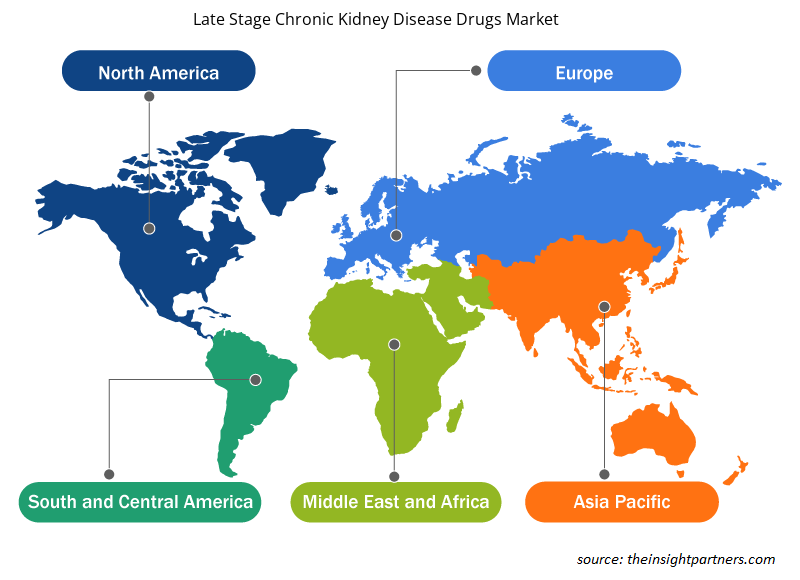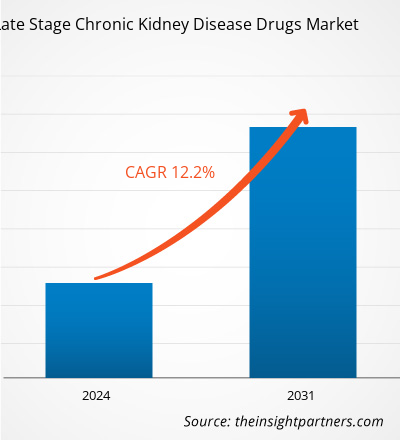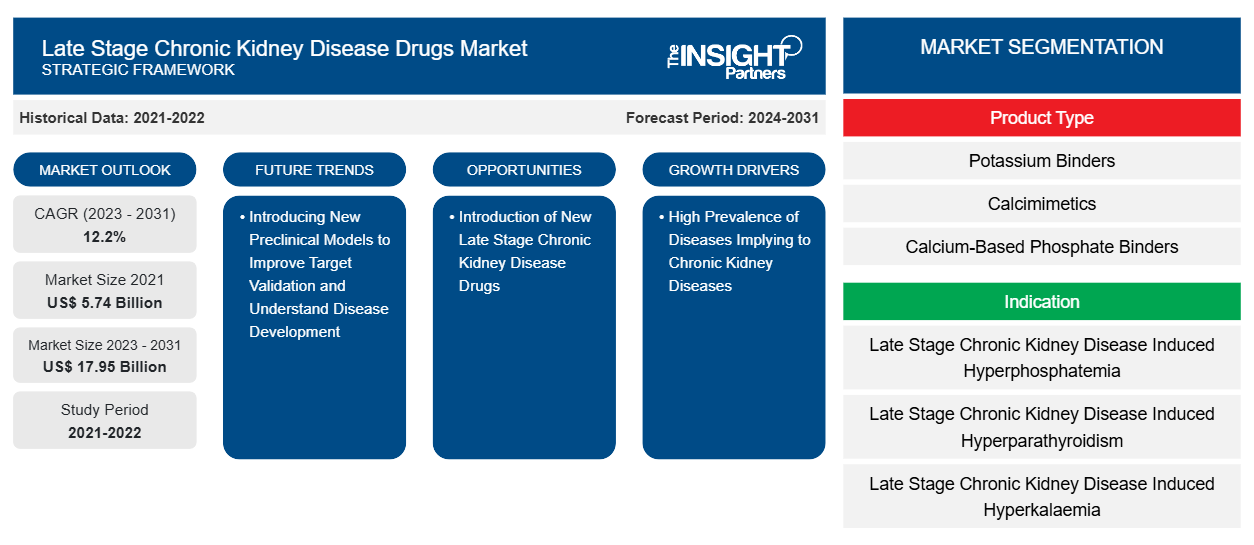後期慢性腎臓病治療薬の市場規模は、2021年に57億4,000万米ドル、2023年に20億米ドルと推定され、2031年までに179億5,000万米ドルに達すると予想されています。また、2023年から2031年にかけて12.2%のCAGRを記録すると予測されています。慢性腎臓病につながる疾患の有病率の高さと有利な償還方針が推進要因です。標的の検証を改善し、疾患の進行を理解するための新しい前臨床モデルの導入は、後期慢性腎臓病治療薬市場の動向にとって引き続き鍵となるでしょう。
慢性腎臓病後期治療薬市場分析
WHOは、重要な医薬品リストの概念やユニバーサル・ヘルス・カバレッジ(UHC)アプローチなど、適切な政策を策定する政策立案者を支援するためのさまざまな戦略を策定しています。さらに、先進的なUHCおよび社会保障制度を備えた欧州諸国は、国民にさまざまな重要な医薬品を無料または割引価格で提供することを目的とした医薬品の価格設定および償還制度を開発しました。さらに、2024暦年のESRD PPSに基づき、メディケアは、腎透析サービスを提供するために約7,900のESRD施設に67億ドルを支払う予定です。最終的な2024暦年のESRD PPS基本料金は271.02ドルで、現在の2023暦年の基本料金265.57ドルから5.45ドル増加しています。
慢性腎臓病後期治療薬市場の概要
アジア太平洋地域は、末期慢性腎臓病治療薬の市場が最も急速に成長しています。この成長は主に、末期腎不全患者数の増加と、糖尿病および高血圧(腎不全の主な原因)の罹患率の上昇によって促進されています。アジア太平洋諸国では、初期段階のCKD患者が末期腎不全(ESRD)に進行し、異なる割合で腎代替療法に依存しています。CKDは、高齢化と、糖尿病や高血圧などのCKDのリスク要因の負担増加により、世界中で主要な死亡原因の1つとして増加し続けています。
要件に合わせてレポートをカスタマイズする
このレポートの一部、国レベルの分析、Excelデータパックなど、あらゆるレポートを無料でカスタマイズできます。また、スタートアップや大学向けのお得なオファーや割引もご利用いただけます。
-
このレポートの主要な市場動向を入手してください。この無料サンプルには、市場動向から見積もりや予測に至るまでのデータ分析が含まれます。
後期慢性腎臓病治療薬市場の推進要因と機会
慢性腎臓病につながる疾患の有病率の高さ
国立医学図書館によると、慢性腎臓病 (CKD) は世界中で主要な公衆衛生問題として認識されています。世界的に、CKD の推定有病率は 13.4% で、腎代替療法を必要とする末期腎疾患 (ESKD) の患者数は 490 万 2 千人から 708 万 3 千人と推定されています。さらに、米国疾病管理予防センター (CDC) は、米国では成人の 7 人に 1 人以上、つまり 3,550 万人、つまり 14% が CKD に罹患していると推定されると発表しました。また、CKD に罹患している成人の 10 人中 9 人は、そのことに気づいていません。
慢性腎臓病後期の新たな治療薬の導入 – チャンス
メーカーは、新薬を開発し、世界中の患者が容易にアクセスできるようにするために、製品の発売と承認、研究開発への投資、政府の資金提供、パートナーシップなどの戦略を採用することに重点を置いています。たとえば、2021年4月、米国食品医薬品局は、腎機能の低下、心血管死、腎不全、および病気の進行リスクがある慢性腎臓病に関連するその他の問題のリスクを軽減するために、Farxiga(ダパグリフロジン)経口錠を承認しました。
北米、ヨーロッパ、アジアのさまざまな国で薬物の採用が大幅に増加しました。
後期慢性腎臓病治療薬市場レポートのセグメンテーション分析
後期慢性腎臓病治療薬市場分析の導出に貢献した主要セグメントは、製品タイプ、適応症、流通チャネルです。
- 製品タイプに基づいて、後期慢性腎臓病治療薬市場は、ビタミンD、カルシウムベースのリン酸結合剤、カリウム結合剤、カルシウム模倣薬、その他に分類されます。カルシウム模倣薬セグメントは2023年に最大の市場シェアを占め、同じセグメントは予測期間中に最高のCAGRを記録すると予想されます。
- 適応症に基づいて、末期慢性腎臓病薬市場は、末期慢性腎臓病誘発性副甲状腺機能亢進症、末期慢性腎臓病誘発性高リン血症、および末期慢性腎臓病誘発性高カリウム血症に分類されます。末期慢性腎臓病誘発性副甲状腺機能亢進症セグメントは2023年に最大の市場シェアを占め、同じセグメントは予測期間中に最高のCAGRを記録すると予測されています。
- 流通チャネルに基づいて、慢性腎臓病後期治療薬市場は、病院薬局、オンライン薬局、小売薬局に分類されます。病院薬局セグメントは2023年に最大の市場シェアを占めました。ただし、オンライン薬局は予測期間中に市場で最も高いCAGR 12.2%を記録すると予測されています。
慢性腎臓病後期治療薬の地域別市場シェア分析
後期慢性腎臓病治療薬市場レポートの地理的範囲は、主に北米、アジア太平洋、ヨーロッパ、中東およびアフリカ、南米/中南米の 5 つの地域に分かれています。
北米の後期慢性腎臓病治療薬市場は、米国、カナダ、メキシコに分かれています。2023年には、北米の後期慢性腎臓病治療薬市場で米国が最大のシェアを占めました。北米の後期慢性腎臓病治療薬市場の成長予測は、主要な市場プレーヤーの存在、末期腎不全と慢性腎臓病の増加、さまざまな学術研究機関による広範な研究開発によって支えられています。CKDは、国内外で大きな公衆衛生上の負担となっています。CKDの世界平均有病率は13.4%で、カナダ国内では最新の推定で少なくとも400万人がこの病気にかかっています。CKDは医療制度に大きな負担をかけています。最近の推定では、CKDを患うカナダ人の医療費は年間400億米ドルを超えています。この病気は、高血圧、心血管疾患、糖尿病、その他の健康状態に悪影響のある患者に多く見られます。
慢性腎臓病後期治療薬市場の地域別分析
予測期間を通じて後期慢性腎臓病薬市場に影響を与える地域的傾向と要因は、Insight Partners のアナリストによって徹底的に説明されています。このセクションでは、北米、ヨーロッパ、アジア太平洋、中東、アフリカ、南米、中米にわたる後期慢性腎臓病薬市場のセグメントと地理についても説明します。

- 後期慢性腎臓病治療薬市場の地域別データを入手
後期慢性腎臓病治療薬市場レポートの範囲
| レポート属性 | 詳細 |
|---|---|
| 2021年の市場規模 | 57億4千万米ドル |
| 2031年までの市場規模 | 179.5億米ドル |
| 世界のCAGR(2023年~2031年) | 12.2% |
| 履歴データ | 2021-2022 |
| 予測期間 | 2024-2031 |
| 対象セグメント |
製品タイプ別
|
| 対象地域と国 |
北米
|
| 市場リーダーと主要企業プロフィール |
|
後期慢性腎臓病治療薬市場のプレーヤー密度:ビジネスダイナミクスへの影響を理解する
後期慢性腎臓病治療薬市場は、消費者の嗜好の変化、技術の進歩、製品の利点に対する認識の高まりなどの要因により、エンドユーザーの需要が高まり、急速に成長しています。需要が高まるにつれて、企業は提供を拡大し、消費者のニーズを満たすために革新し、新たなトレンドを活用し、市場の成長をさらに促進しています。
市場プレーヤー密度とは、特定の市場または業界内で活動している企業または会社の分布を指します。これは、特定の市場スペースに、その規模または総市場価値と比較して、どれだけの競合相手 (市場プレーヤー) が存在するかを示します。
後期慢性腎臓病治療薬市場で事業を展開している主要企業は次のとおりです。
- アッヴィ株式会社
- アムジェン
- アストラゼネカ
- サノフィ
- 協和キリン株式会社
- 武田薬品工業株式会社
免責事項:上記の企業は、特定の順序でランク付けされていません。

- 後期慢性腎臓病治療薬市場のトップキープレーヤーの概要を入手
慢性腎臓病後期治療薬市場のニュースと最近の動向
末期慢性腎臓病治療薬市場は、主要な企業出版物、協会データ、データベースを含む一次および二次調査から定性的および定量的データを収集して評価されます。以下は、末期慢性腎臓病治療薬市場の動向の一覧です。
- サンファーマとバイエルは、慢性腎臓病の治療薬を共同で販売することに合意しました。契約条件に基づき、バイエルはサンファーマに、リベルサというブランド名で2番目のフィネレノン製品を販売および流通する非独占的権利を付与しました。(バイエル/プレスリリース、2024年1月)
- ベーリンガーインゲルハイムはイーライリリー・アンド・カンパニーと共同で、慢性腎臓病(CKD)の成人における腎臓病の発症および心血管死のリスクを軽減する可能性のある治療薬として検討されているジャディアンス(エンパグリフロジン)錠のFDA承認を発表しました。(出典:ベーリンガーインゲルハイムインターナショナルGmbH、プレスリリース、2023年10月)
後期慢性腎臓病治療薬市場レポートのカバー範囲と成果物
「後期慢性腎臓病治療薬市場規模と予測(2021〜2031年)」レポートでは、以下の分野をカバーする市場の詳細な分析を提供しています。
- 対象範囲に含まれるすべての主要市場セグメントの世界、地域、国レベルでの市場規模と予測
- 市場の動向(推進要因、制約、主要な機会など)
- 今後の主な動向
- 詳細なPEST/ポーターの5つの力とSWOT分析
- 主要な市場動向、主要プレーヤー、規制、最近の市場動向を網羅した世界および地域の市場分析
- 市場集中、ヒートマップ分析、主要プレーヤー、最近の動向を網羅した業界の状況と競争分析
- 詳細な企業プロフィール
- 過去2年間の分析、基準年、CAGRによる予測(7年間)
- PEST分析とSWOT分析
- 市場規模価値/数量 - 世界、地域、国
- 業界と競争環境
- Excel データセット
最新レポート
関連レポート
お客様の声
購入理由
- 情報に基づいた意思決定
- 市場動向の理解
- 競合分析
- 顧客インサイト
- 市場予測
- リスク軽減
- 戦略計画
- 投資の正当性
- 新興市場の特定
- マーケティング戦略の強化
- 業務効率の向上
- 規制動向への対応























 無料サンプルを入手 - 慢性腎臓病後期治療薬市場
無料サンプルを入手 - 慢性腎臓病後期治療薬市場